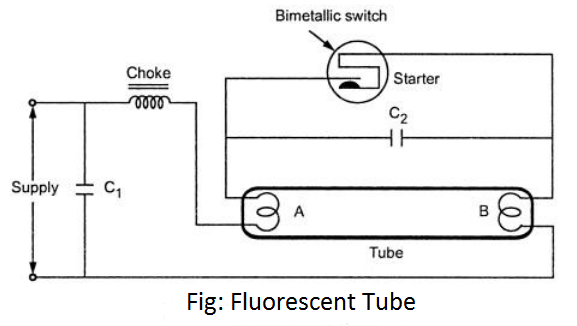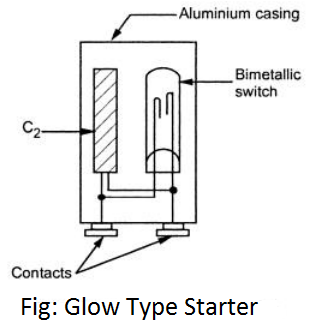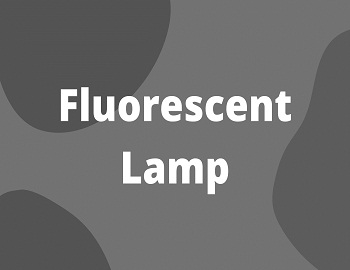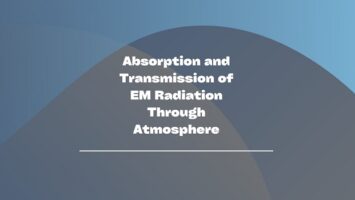Fluorescent Lamp:

The above figure shows the constructional details of the Fluorescent Lamp. It consists of a long glass tube which is internally coated with a suitable amount of fluorescent powder. A small amount of mercury along with a little quantity of argon gas is also filled in the tube.
There are two electrodes A and B made up of coiled tungsten filament coated with an electron-emitting material. The control circuit of the tube contains glow type starter, choke L and two capacitors C1 and C2.
The below figure shows a cut section of a glow-type starter.

There are two electrodes of which one is fixed while the other is U shaped bimetallic strip made of two different metals. These electrodes are sealed in a glass bulb which is filled with a mixture of helium and hydrogen. The contacts are normally open.
Working: When the supply is switched ON, an electric arc is established between the electrodes of the starter due to the flow of current through the small air gap between the electrodes. Due to this arc, heat is produced which is sufficient to bend the bimetallic strip which makes contact with the fixed electrode. This closes the circuit and therefore choke carries a large current. Once the electrodes close, the arc vanishes and bimetallic strips cool down again.
Now electrodes A and B become hot and due to cooling the choke circuit opens. The current through the choke coil is suddenly reduced to a small value. This change in current induces an e.m.f. which is very high of the order of 1000 V, in the choke coil. This e.m.f. induced is sufficient for ionizing the gas molecules between electrodes A and B which establishes the discharge between electrodes A and B through the gas.
The potential difference across the tube falls to about 100-110 V which is sufficient to maintain the discharge but not sufficient to restart the glow in the circuit.
So even if the starter is removed from the circuit, discharge continues as the current flows from electrodes A and B due to the ionization of the gas. If the supply voltage is low, there is difficulty in starting the tube as the low voltage is insufficient to establish a glow in the starter.
As the choke lowers the power factor, the capacitor C1 used in the circuit improves the power factor of the circuit.
The capacitor C2 suppresses the radio interference developed due to arcing. The function of the inductive choke is to supply a large voltage surge for establishing the discharge between electrodes A and B.
Advantages: (i) The light available is much more than the normal incandescent lamp. A fluorescent lamp gives 2200 to 2400 lumens while a normal lamp gives 600 lumens.
(ii) The life of the fluorescent tube is much more than the incandescent lamp.
(iii)The fluorescent tube gives the effect of daylight while the incandescent lamp gives yellowish light.
(iv) Low power consumption.
(v) High efficiency.
(vi) Instantaneous switching without any warming period.
(vii) Using different fluorescent materials various coloured lights can be obtained.
Disadvantages: (i) Very high initial cost.
(ii) Produces radio interference.









Comments (No)